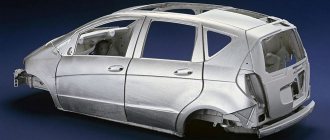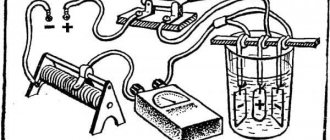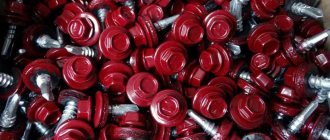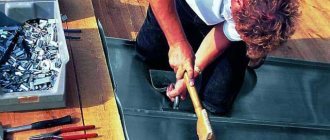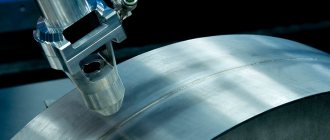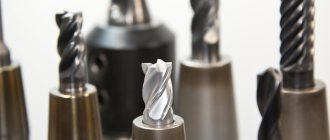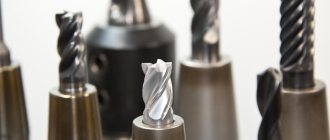Peugeot and Citroen cars have zinc body protection - complete, double-sided, outside and inside. It is galvanized by electrodeposition using the cataphoresis method. Galvanizing is the most popular method of protecting a car from corrosion. There is simply no more effective technology for protecting bodywork from destruction in the automotive industry. However, even reputable auto media manage to publish such fantastic nonsense about “galvanizing” that you wonder whether these people even went to school. What’s worse is that gullible readers are “led” by this nonsense. Let's talk about what “body galvanization” actually is, so that your choice is reasoned and correct
How to protect your car from corrosion
Why galvanize at all, and not tin or copper plating?
Automotive body steel is a complex and delicate alloy! It has nothing in common (except the presence of iron and carbon), for example, with “roofing sheet”. This alloy must ideally meet many special, often mutually exclusive, requirements. Therefore, its composition, chemical and heat treatment are always a compromise.
Only stainless steel does not rust (for example: 12Х18Н10Т) and 100% pure iron (it can only be obtained in space). Everything else where iron is present rusts, that is, it naturally oxidizes, because “Ferrum” (Fe, iron) is a very active chemical element.
A car can also be made from stainless steel, but in this case its body will be monstrously expensive and terribly low-tech. The only example is the DeLorean DMC 12, which became a legend thanks to the Back to the Future series. The irony is that having already become a “movie star,” John DeLorean’s company, which produced this stunning coupe, had by that time gone bankrupt due to the terrible costs of its production. The body can also be made from ordinary “roofing iron”, but then it will quickly crumble, wrinkle, deform, and be terribly heavy, albeit cheap.
John DeLorean (ex-President of Pontiac and Vice President of General Motors) and his “stainless” DMC 12
The main enemy of iron (Fe) is oxygen (O2)! O-two is found everywhere. It is present in small quantities even inside any part made of steel or other metals and alloys. Accordingly, if there is iron and air, after some time a corrosive coating appears. If water vapor also appears, especially water, the process accelerates hundreds, and sometimes thousands of times!
The main thing is the quality of the body steel
Friends! Please note - every year cars increase in size, expand and their configurations become more complex, but at the same time they become lighter and lighter! It’s interesting, what if the “naked” body of any of the modern cars, having the same characteristics of rigidity and strength, would have been created 30-40 years ago? It would weigh several tons, but today it would weigh some 300-400 kg! Because of which? It’s not because of the plastic, since we’re looking at a “naked” metal body?
Another interesting pattern: when introducing new models to the market, reputable manufacturers increasingly mention the use of super-strong and even hyper-strength steels with the highest elastic modulus values, which previously seemed fantastic, in their designs.
On the left is the body of a Peugeot 308 II (2013). On the right is the body of a Peugeot RCZ (2009). Notice how the use of hyper-strength steels has increased
“The box opens simply” - achieving such high performance becomes possible thanks to special heat treatment technologies for body elements and the introduction of metal alloys into the composition, allowing these elements to be “hardened” (I use this term to simplify understanding). The most common technology is that after multi-stage stamping, the part is subjected to complex heat treatment, with several temperings and heating (including “local” using high-frequency frequencies). In fact, pick up the wing of a modern car: it will be complex in shape, with intricate curves, thin and light, and... so strong that it is almost impossible to bend it with your hands, and when you tap your knuckles, you can hear a characteristic “boooommmm!” indicating , that this “piece of hardware” is clearly “hardened”.
“The other side of the coin” is the small thickness of the steel. If in the 60-70s body “tin” of 1.5-2 mm was considered thin, then in the second decade of the 21st century, tail metal of 0.25-0.5 mm became commonplace.
Naturally, the corrosion resistance of such thin structures comes to the fore, since now safety directly depends on it. In addition to the negative factors that directly affect the rate of occurrence and spread of corrosion - high temperature, the presence of moisture and salts, stone piercing and sandblasting - increased requirements for the quality, cleanliness and structure of body steel have been added. And here Peugeot, the PSA Group and Stellantis have traditional historical advantages over most other brands...
Steel and Peugeot
Long before the advent of the automobile, more than 200 years ago, the Peugeot family began to engage in metalworking and metallurgy, quickly gaining worldwide authority in this business. Peugeot is the inventor of cold rolling technology for steel and many alloys of ferrous and non-ferrous metals.
Peugeot steel and metalworking plant in Terre Blanche 1881. It was 10 years before the first Peugeot car appeared.
Having started producing cars back in the 19th century, Peugeot invested in them all its enormous metallurgical potential, know-how and advanced developments. The PSA and Stellantis group is one of the few car manufacturers that has its own, very impressive steel production, supplying its products not only to other car brands, but also to other industries.
The production of “clean steel” and alloys with a minimum content of impurities for body engineering has become a kind of “calling card” for PSA, a clear confirmation of which is the image of Peugeot and Citroen as “stainless” cars.
You may be surprised, but... Peugeot is among the inventors of special dental alloys!
This set was intended for dentists in 1884. “Clean steel” is a steel with a low content of soluble impurities and a minimum number of defects associated with the presence of oxides. The presence of elements in steel such as carbon, phosphorus, sulfur, nitrogen, hydrogen and oxygen can have a great influence on its most important properties for the automotive industry:
- tensile strength;
- ability to undergo plastic deformation without cracking during stamping;
- viscosity;
- weldability;
- crack resistance;
- corrosion resistance;
- fatigue strength.
The mutual influence of the listed elements on the properties of steel can be both beneficial and harmful. For example, carbon and nitrogen increase the hardenability of steel, but reduce its ductility, phosphorus also increases hardenability, but contributes to its brittleness, oxygen and sulfur (oxides and sulfides) make steel resistant to abrasion, but negatively affect toughness and fatigue strength. Therefore, for various applications, the number and size of inclusions are limited.
For comparison:
- In sheet steel for stamping barrels, the maximum oxygen content should not exceed 30 parts per million (ppm), nitrogen - 40 ppm, and the maximum size of non-metallic inclusions - no more than 100 microns;
- In sheet steel for automobile bodies, the maximum oxygen content is no more than 20 ppm, nitrogen – 30 ppm, and the maximum size of non-metallic inclusions is no more than 40 microns.
There is another important factor in the influence of impurities contained in body steel - susceptibility to the necessary chemical treatment and friendliness to protective coatings, of which the so-called “galvanization” comes first.
Why apply zinc to metal?
The main advantages of using galvanized steel include:
- Lower cost compared to stainless steel.
- The best value for money. Minimum maintenance costs and long-term operation.
- Reliable performance characteristics of the coating.
- Exceptional resistance to mechanical damage.
- Protects small areas of steel susceptible to scratches.
- No other coating can provide the same protection.
Prevention of corrosive plaque
The car body is not only the most expensive, but also from the point of view of strength of materials (resistance of materials) - the most important part of the car. While driving on a regular road (not to mention off-road and accidents), it has to experience a huge number of various deformations, be subject to vibrations and dampen them, dissipate energy, etc., etc. Therefore, any thinning, hole or weakening of any of its elements is a potential stress raiser and a source of problems. On a rusty, “rotten” body, a hole or a place appears where it will someday break, break, and... it’s good if this happens somewhere “in the open field”, and not in a high-speed accident! Holes and weakening of body elements primarily appear due to the destruction of metal by oxygen, the appearance of rust, and then a through hole...
Electrochemical series of elements (school chemistry course):
Li→Rb→K→Ba→Sr→Ca→Na→Mg→Al→Mn→Cr→Zn→ Fe →Cd→Co→Ni→Sn→Pb→H→Sb→Bi→Cu→Hg→Ag→Pd→ Pt→Au
Let's find Iron (Fe) in it. Now look: metals that are more active than iron are located to the left of it, less active ones are to the right.
If we cover a sheet of iron with zinc (Zn) or zinc-containing substances (hereinafter simply “Zinc”), then this layer will prevent oxygen from penetrating the iron and oxidizing it, making it rusty. If the zinc layer is damaged, then the place of damage with direct contact of iron with air will inevitably begin to be oxidized by oxygen.
If a layer of iron is coated with tin (Sn) or copper (Cu), which are less active than Fe and are located to the right of it, if the layer is damaged, the iron will actively begin to oxidize - the layer of tin or copper will remain intact, but the iron underneath will quickly rust out. "! Therefore, car bodies were never tinned (i.e. covered with tin) or copper plated!
Zinc, as a more active metal, “takes on” the entire “chemical-oxidative load”. If the iron is coated with zinc, then if its layer is damaged, the sheet will rust not in depth, but in width! Thus, the zinc layer prevents the appearance of through holes on the body. Oxidation (rusting) will occur in any case! However, the source of rust will not be directed inside the part, but along its surface.
The essence of “galvanization”: even if the paint coating has “swollen”, the part is intact and there is not even a hint of “rot”. This can be easily restored!
Example No. 1 Take a look at the sills of used Japanese cars - everything seems to be fine, but upon closer inspection we will see small through holes. Alas, the bodies of even the famous “Japanese”, and with them, alas, the “Koreans”, if the damage to their paintwork is not repaired in time, are capable of rotting through and through in one Moscow winter season (“thanks” to caustic deicing agents)
Example No. 2 Take a look at the bodies of the oldest Peugeot and Citroen that you can find - they may have round “ulcers” with peeling paint, in the middle of these “ulcers” you can even discern brown fragments (yes, yes - this is a corrosion coating) , but... there will not be a single through hole on the body! Of course, if the case is completely neglected or the repairs were carried out using barbaric methods (heating the sills with a blowtorch and pulling out dents using “tendrils”), then holes may occur, but for this the car will need to drive through the Moscow “cocktail streets” for several years without washing or repairing paintwork , which only happens to the most careless owners!
Historical information: in 1975, the world's two first cars with fully galvanized bodies were born - these were the Peugeot 604 and Porsche 924. The German chemical concern BASF took part in the development of the technology. Since then, all Peugeots and Porsches have been "stainless".
A fragment of a Peugeot 604 advertising brochure describing the process of galvanizing the body.
Thus, if damage to the metal appears on the surface of a car with a galvanized body, then after some time rust will inevitably appear at the source of the damage. There's no escaping this. The zinc layer gives you much more time to repair this damage than if this layer is not present. The damage must be repaired in any case, and the sooner the better!
And don’t listen to the stories of all sorts of “garage storytellers” that they say he drove such and such a car with a deep scratch for 5-10 years and there wasn’t even a hint of rust... This is a myth! Such an owner is a slob, a dirty person and a chump: after all, if he cuts his hand, he will immediately run to smear it with brilliant green or stick a band-aid on it... but the car itself cannot do this!
Outwardly, a rather neat Japanese crossover of a reputable brand in the conditions of Moscow has rotted almost to the core in 7 years! Clearly the owner's fault. I had to look after
Classification
Galvanized steel sheet has several classifications, on which the further scope of application depends.
- Depending on the purpose, galvanized steel is distinguished: KhP - cold profiling; PC - for painting; ХШ - cold stamping; OH - general purpose.
- Sheets used for cold stamping are divided into groups according to their ability to draw: N - normal; G - deep; VG - very deep.
- Depending on the thickness of the zinc coating, the sheets are divided into: HP - normal; UR - reduced.
- Depending on the thickness of the coating, the sheets are divided into: P - increased class (60 - 40 microns); B - high class (40 - 18 microns); O - normal class (18 - 10 microns).
A galvanized sheet can have a crystallization pattern (CR) or without a pattern (MT) on the surface of the sheet.
The sheet is also classified according to rolling accuracy: increased (A), normal (B) and high (C). When choosing a galvanized sheet, you should take into account the scope of its application and the environmental conditions in which it will be used.
Types of car body protection
What is galvanizing really?
Generally speaking, “galvanization”: the term is common, simplified and, if we consider it in its literal meaning, it is far from automotive reality, and therefore incorrect! But this process has a correct, albeit long, but accepted name among professionals - phosphating with passivation and subsequent electrodeposition of zinc-containing soil using the cataphoresis method.
Phosphating is the coating of body metal with a thin layer of zinc phosphate to increase hardness and protect against corrosion.
Passivation (derived from the word “passivity”) is the formation of a thin oxide film on the metal surface that prevents the formation of corrosion. The thickness of the oxide film on the surface of body steel is several nanometers (1 nanometer = 10−9 meters). In fact, passivation is the deliberate destruction of the outer layer of metal under the action of a complex oxidizing agent with the formation of persistent salts and oxides, which make up the protective film.
Zinc phosphate (Zn3(PO4)2) is an anti-corrosion substance, which is a fine white powder, has almost zero toxicity, increases the adhesion of paintwork to the body metal and improves the protective properties of paint and varnish coatings.
The chemical protection mechanism is as follows: under the influence of water penetrating through the paintwork, zinc phosphate enters a dissociation reaction to form a complex acid, which reacts together with the oxide film (obtained through passivation) to iron ions in areas of corrosion of body steel, resulting in the formation of a durable complex inhibitor corrosion.
Passivation and phosphating are carried out by dipping a previously thoroughly cleaned and completely degreased body into a bath with a solution of zinc phosphate in demineralized water with the addition of acids and reaction activators. The passivation and phosphating time usually takes from 3 to 7 minutes.
The color of phosphate coating usually ranges from light gray to dark gray. A greenish tint is added to the gray when body steel contains chrome and nickel.
Electromechanical method of protecting the body from rust
After phosphating, the entire surface of the body in a cataphoresis bath is covered with a layer of protective zinc-containing primer, consisting of zinc phosphate, polymers and pigment. This layer is the basis for the subsequent application of paint and varnish. Possessing high adhesion, under the influence of electrical potential differences, soil particles penetrate into the surface of the phosphated metal so deeply and densely that any clear boundary between the metal and the soil virtually disappears. This effect must be taken into account when using various thickness gauges to assess the condition of a car’s paintwork.
After passivation and phosphating, this Citroen C3 I body is subjected to cataphoretic coating with zinc-containing primer
Cataphoresis is the process of transfer (electrodeposition, electrophoresis) of a substance from an electrolyte solution under the influence of an electric current, when the primer or paint is the anode (“plus”), and the body or its part is the cathode (“minus”). Cathodic protection is not quite the correct name for this process in the driving community.
A brief historical background on the use of electrophoresis in the automotive industry...
1963 – the first industrial application of anaphoresis primer on small parts;
1967 – the first experimental line of body painting using anaphoresis;
1974 – first application of cataphoretic primer in the USA;
1975 – launch of the Peugeot 604 and Porsche 924 cars, the bodies of which were completely covered with a primer containing zinc phosphate using cataphoresis for the first time in the world.
Combined protection
Advantages of the method of applying primers and paints using cataphoresis:
- Full automation of the application process, in which a person participates only as an observer/controller;
- Short application time - it takes only 3-5 minutes to process one body;
- High quality of coating - all parts of the body, both internal and external, are covered, while the occurrence of coating defects is almost completely eliminated;
- High efficiency and efficiency - up to 100% of unused primer or paint remaining in the cataphoresis bath can be reused to cover the next body;
- Environmental friendliness and safety - the primer or paint has a water-soluble base and no more than 2% organic solvents, they do not contain lead, chromium, antimony and any other harmful metals and their compounds, there is a complete absence of emission of harmful gases, fumes and slags.
The properties of the protective primer and the cataphoretic method of its application are such that they provide today the best characteristics of anti-corrosion protection of the body from any external influences.
The 604 may have been the first to use galvanization, but the Peugeot 504 was the first to win the glory of being “stainless.” The photo shows the “504” painting area in Sochaux. 1981
Additional benefits of protective cataphoretic primer:
- Smoothing and leveling of small irregularities on the surface of the body, which improves its appearance after painting;
- Increasing the warranty period for the absence of through body corrosion from 6 to 12 years;
- Protection from external impacts from solid objects (stones, gravel, pieces of wood, etc.);
- Maintaining the thickness of the primer coating on sharp parts of the body (edges of doors and hood, flanges and rolling);
- High penetrating ability and fluidity, due to which the possibility of high-quality processing of body parts of particularly complex shapes is realized;
- Protection of bodies made of a wide range of metals and their alloys (steel, aluminum, duralumin, silumin, magnesium and titanium alloys);
- Wide ranges of drying parameters in terms of time and temperature.
After applying a protective zinc-containing cataphoresis primer, the body is subjected to combined drying with streams of sterile air under the influence of infrared radiation lamps, after which a layer of paint (painting) primer is applied to its surface, also by cataphoresis. This soil no longer contains zinc phosphate. Its purpose is to become the basis for the future paintwork of the car, to ensure high adhesion of decorative enamels and varnishes.
This is how the “galvanization” of the best cars in terms of corrosion resistance occurs, including Peugeot, Citroen and Porsche, which became pioneers in the field of anti-corrosion protection back in 1975.
Modern technology for processing car bodies of Peugeot, Citroen, DS and Opel
What is galvanizing
Galvanizing is a technological process that involves applying zinc to a metal surface. The purpose of this manipulation is to create a protective layer.
Galvanized body, according to statistics, lasts much longer. An example is Audi cars. Thanks to full galvanization, produced at the factory, body parts do not wear out for 20-35 years.
The service life of a galvanized machine is influenced by the characteristics of the application method chosen by the manufacturer. Full galvanizing provides maximum protection, while spot finishing does not provide the same results. Unfortunately, many manufacturers practice partial application, as this significantly reduces production costs.
Information about the galvanizing method is specified in the technical documents of each machine. Markings may be: “zinc”, “fully galvanized” or “cold galvanized”.
What are the supposed experts wrong about...
The worst thing is that informational “pearls” that have nothing to do with reality, akin to the fruit of a sick imagination, regularly appear not only among bloggers, but also on the pages of highly respected automobile publications. If you compile the contents of articles devoted to the “galvanization” of bodies, then they will all come down to one seditious quote...
“There are 4 ways to galvanize a body. Here they are arranged in order of increasing effectiveness:
- Cold galvanizing;
- Zinc metal;
- Galvanic method of applying zinc;
- Hot galvanized."
This listing itself already raises serious doubts about the professionalism, competence and level of knowledge of the authors! We will talk about “hot-dip galvanizing”, the mention of which in an automotive context is complete nonsense, in a separate chapter.
Galvanic galvanizing - reality and fiction
Allegedly, “cold galvanizing”, “zinc metal” and “galvanic method of applying zinc” are nothing more than three types of descriptions of the same process - phosphating followed by application of a zinc-containing protective primer to the surface of the body by electrophoresis.
The real differences in the types of this method concern only the nuances: whether passivation is carried out or not, how phosphating is carried out - chemical or electrochemical, what is the composition of the ingredients in the primary electrolyte solution. Of course, first of all, everything depends on quality and adherence to technological culture. But all this is on the conscience of the car manufacturer. The rest does not have any special differences and does not depend on the suppliers of technologies and chemicals.
The second, persistently circulating misconception concerns certain “types of galvanizing”, of which two are almost universally distinguished:
- “full galvanization”, when all body elements inside and outside are coated with zinc;
- “partial galvanization”, when only the most susceptible to corrosion and impact-abrasive areas of the body, usually “to the waist,” are coated with zinc.
The fact is that it makes no sense to phosphate and/or cover the car body with zinc-containing primer “to the waist” or “to the roof” - in any case, the ENTIRE body will have to be treated: either completely, or not do it at all. The technology is such that the body in electrophoresis baths must be constantly rocked and turned over, and the electrolyte must be continuously stirred.
Even immersing the body in the bathtub must be in a position close to vertical, from top to bottom and at a certain speed. If you simply “plop” the body into the bath and, in a semi-submerged state, carry it through the electrolyte, then, after removing and drying, its entire surface will be replete with defects, the soil will lie unevenly, and the thickness of the layer will be extremely uneven. Eliminating defects will require a gigantic amount of manual labor with the negative presence of the “human factor”, and because of this, inevitably huge financial losses. The technology of completely processing the body, completely immersing it in the bath, is absolutely free of all these troubles.
So, we have found out that at present, as before , only one method of galvanizing a body is used in the global automotive industry - coating it in an electrophoresis bath with a thin anti-corrosion layer of zinc-containing substances by electrodeposition onto the surface of the body from an electrolyte, where these substances are contained in form of a colloidal solution.
The time has come to debunk the most monstrous myth about “hot-dip galvanization,” which is steadily circulating in the minds of the automotive community.
“Hot-dip galvanizing” is a figment of a sick imagination
The so-called “hot-dip galvanizing” is not used in the passenger car body industry, has never been used before and (God forbid) will never be used in the future! I would like to make a special point - “hot-dip galvanizing” has NEVER been used and IS NOT USED!!! And that's why …
In terms of beauty and delicacy of the design, the body of the Peugeot 2008 I can be compared with the Eiffel Tower)))
Imagine... A beautiful, openwork, light, almost airy, intricate and complex-shaped body, assembled from many fragments of steel with a variety of characteristics, just welded on a conveyor belt by ultra-precise (!) robots, for galvanizing, it is lowered into... “a bath of molten zinc , the temperature of which is from 500°C to 800°C” - which can sometimes be read not only from bloggers, but also on the pages of highly respected automotive publications.
At 500°C, precision heat-treated body panels... will instantly “release”, and super- and hyper-strong steels will immediately turn into “plasticine”! This should be clear to anyone who has ever stuck a nail into a fire and seen what happens to it after that... At 500°C, the openwork body will experience such high thermal overloads and deformations that it will, in the most literal sense, be torn at the seams! Even if it doesn’t tear, it will twist worse than Quasimode from “Notre Dame in Paris,” and there will be no way to straighten this crumpled piece of foil back!
Lower the temperature? Will not work! The melting point of Zinc is 420°C.
First galvanize the metal, stamp it, and then weld it? It won't work either! The most widely used body welding technology is spot welding. The two parts are tightly connected to each other, compressed in the right place by “pincers” with electrodes, to which a short but powerful electric discharge is applied. Local heating occurs to 1000-1200°C, and the steel is welded at this point.
The next point, another point, another... Now imagine that at the site of this local heating to 1000-1200°C (the melting point of steel) zinc appears with its “ridiculous” melting point of 420°C. This will inevitably lead to the formation of slag, cavities, and burning, which only later, after painting and operation, will become a powerful source of corrosion, incl. and intercrystalline, i.e. internal, without external influence.
Thus, not only will we not protect the body with zinc in any way, but, on the contrary, we will create a huge number of sources for hidden and uncontrolled corrosion to occur. After exposure to vibrations, the weld points will begin to crack and burst, and after some time the body will fall apart at the seams.
By the way, modern technologies, especially those of the PSA Peugeot Citroen Group, have successfully solved this problem! Before connecting the surfaces of steel parts coated with a thin layer of zinc for subsequent spot welding, a special preservative flux is applied to their inner sides facing each other, which eliminates the burning out of zinc and promotes its instant dissolution in the center of molten steel without the formation of slag and defects. The flux located around the welding point and not taking part in the reaction now plays the role of glue, which, after rapid polymerization, not only seals the joint of the parts, protecting the welding point from the inside, but also helps to further increase the rigidity of the structure.
But let’s return to “hot-dip galvanized”
Energy ! Calculate - what a monstrous amount of energy needs to be supplied to a “zinc molten bath” with a capacity of more than 150 m3!!! In addition, this entire volume must be constantly kept at a temperature of at least 500°C, constantly adding and melting new zinc granules! What if the car is produced in a circulation of 500,000 cars per year?
That's 41,670 cars per month, 1,389 per day and 58 cars per hour! This means that you need to lower 1 body per minute into a bath of molten zinc (around the clock, without holidays or weekends!)! ... In this case, next to the automobile plant there should be some kind of nuclear or hydroelectric power station of the “caliber” of the Dnieper Hydroelectric Power Station!
Carving ! On any body, no matter how high-tech it is, there will always be many and different threaded holes in it! The thinnest layer of zinc that can be achieved with hot-dip galvanizing is 0.1 mm! Not microns, but one tenth of a millimeter! There is no way to make the layer thinner using this method. If you cut a thread before galvanizing, then after applying a layer of 0.1 mm to its turns, even if it is M16, it will hardly be possible to screw a bolt into this hole, not to mention threads of a smaller diameter. If you cut a thread after galvanizing, then the whole point is lost - after the tap comes out of the hole, there will be “bare metal” on the surface of the threads, open to any corrosion and unprotected by anything.
Ecology ! In this case, I’m not talking about Greta Thunberg, but about real ecology. Zinc, after it has been melted, let alone brought its temperature to 500-800°C, begins to actively oxidize and react with everything “that comes to hand”, the result is a huge amount of harmful slag that cannot be further processed, poisonous gases and evaporation... Where should all this go? Gases into the atmosphere, and slag into the street? With a “rate of fire” of 1 body per minute, in a year huge stinking waste heaps will rise around the plant, poisoning everything around with miasma. “Birds don’t sing here, trees don’t grow here” (C) will become a terrible reality.
Hot-dip galvanizing is used in the manufacture of lamp posts, water pipes, fences, bridge elements and similar products - where high precision is not needed, and the part is a body part. In the automotive industry, this method is extremely rarely (!) used for galvanizing any brackets for trucks, their frames, struts, etc.
Today, the best, only and well-developed “galvanizing” technology is the technology of electrodeposition onto the surface of the metal body before painting it.
- Environmental friendliness is almost one hundred percent, because no toxins or harmful emissions occur at all.
- Energy consumption is minimal and is required only to maintain the required potential difference on the body and bathtub.
- The layer of zinc-containing coating is thin, about 10 microns, so it does not affect even the smallest body threads.
- The layer is very durable, since microparticles penetrate the surface of the body panel at the molecular (!) level.
- Everything is galvanized, right down to the most delicate nooks and crannies of the body.
- To eliminate defects due to inevitable bubbles, the body is turned over while in the bathroom, and the electrolyte is constantly mixed.
- Drying a newly galvanized body by electrodeposition occurs in the same way as drying after painting it - with a stream of sterile air under infrared lamps.
- A priori, the body cannot experience any heating, and therefore internal temperature deformations and associated stresses.
We will leave for later and at your request a description of new, advanced, albeit exotic technologies that have recently begun to be used in car production (including Peugeot, Citroen and all Stellantis products), but which are the future: gluing, lamination, plasma spraying, etc.
The final inspection of the quality of painting and body assembly on Peugeot and Citroen is carried out by gentle female hands - affectionate, sensitive and very beloved by us)))
Application
In practical life, galvanized sheets are used everywhere. Elements from it can be found in various structures around us, on ships, train stations, billboards, cars, fences and other metal structures. Since the sheet is resistant to corrosion, it has found wide application in modern industry. Such rolled products are used in various areas of production: in the heavy, chemical industries, and in instrument making. Due to the fact that the sheet can be machined, stamped parts and deep-drawn and profiled products are produced from it.
Galvanized sheets are in demand in the mechanical and automotive industries. For example, for the production of a van body or trim. But still, the main area of application for zinc-coated sheets is construction, because it is a durable and high-quality material. It is applicable for construction and installation work, for the construction of metal structures. The structures are quite light, with little load on the walls and ceilings. It can be used to construct a hangar, garage, warehouse, etc. Galvanized sheets are used to line roofs, install ceilings, or use them as a material for walls and flooring.
The sheet is used for exterior finishing of walls, roofs, fences, balconies. It is excellent for cladding buildings. Zinc coated sheet is the basis for the manufacture of a wide range of construction products:
- corrugated sheeting (galvanized or with the addition of polymers to impart protective and decorative properties);
- metal tiles (which are in demand in roofing work);
- picket fence;
- construction profile;
- strip.
Galvanized sheets are used to produce water pipes, air ducts and drains, brackets and all kinds of fasteners, as well as household items. Ventilation systems and kitchen hoods are made from it.

